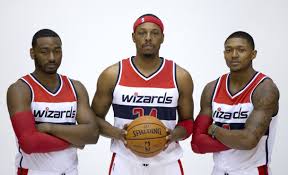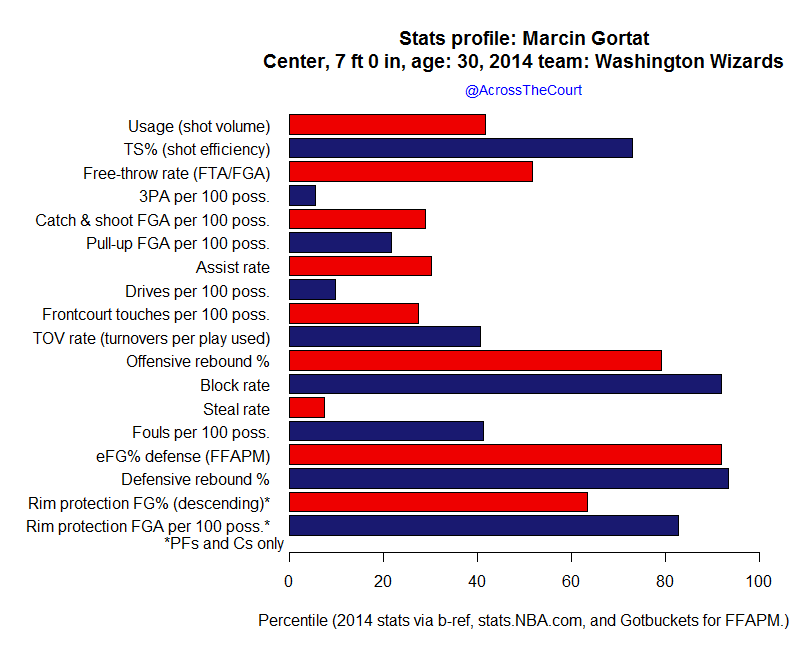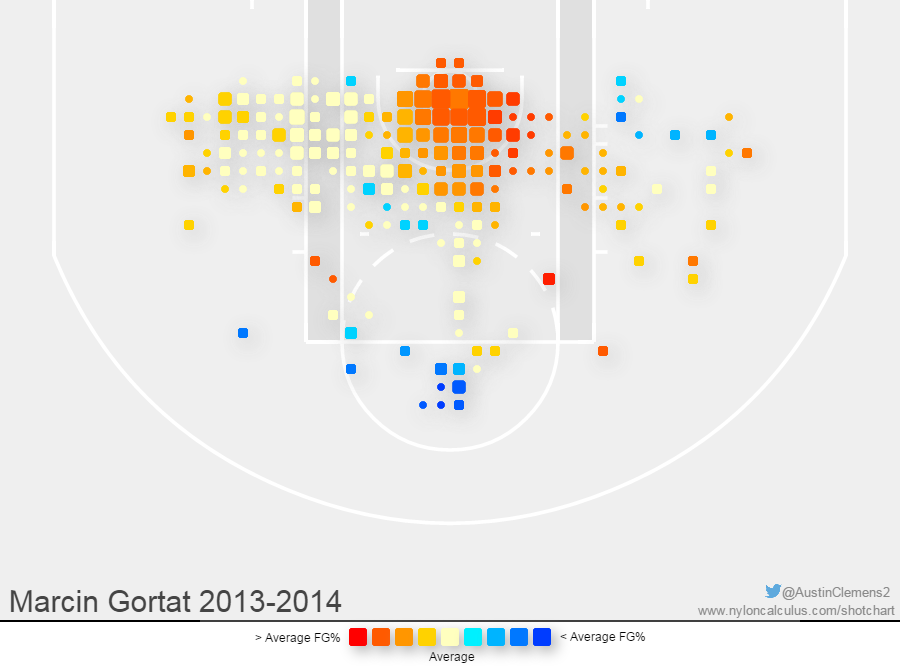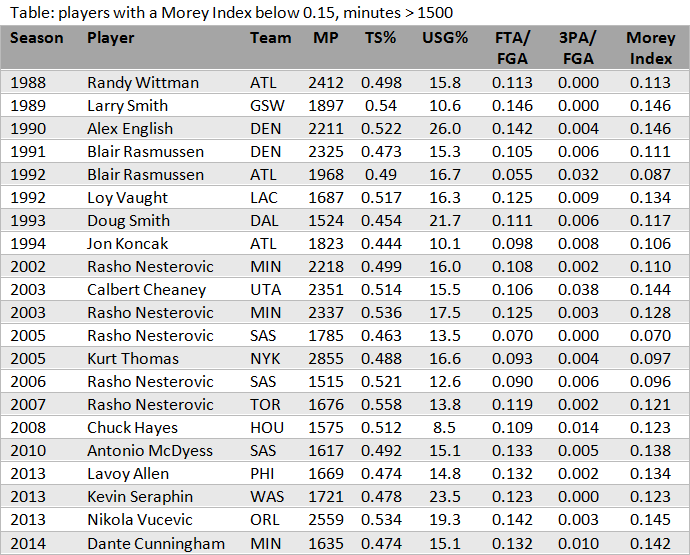There has been little wizardry in Washington over the past few years. The Arenas-Butler-Jamison core failed, and Arenas went into a tailspin. Washington got so bad they were granted the first pick, and finally after a few tries they made it to the post-season. After paying premium to make it there, there’s a question of what happens now with this mix of young guys and veterans in their 30’s.
2014 in review
The Wizards were criticized for letting a draft pick go for Gortat and Okafor’s expiring contract, but it accomplished what they were aiming for: they made the playoffs and with a good seed too. The draft pick they lost was turned into Tyler Ennis, an 18th pick who by judging similar guys in that draft slot probably won’t be a major piece. Gortat saved a Washington frontcourt beset by injuries when Okafor was lost (and eventually traded) to a neck injury and the threat of Nene’s constant problems. Ariza had a career year, feasting on corner three’s and clearing 40%. With the young Beal and Wall backcourt, their starting lineup was one of the best in the league. People will cite the important of Wall and Beal, but it was their big man combination: when Gortat and Nene were on the floor the team scored at a near league average rate, but the team held opponents to 98 points per 100 possessions, outscoring opponents by 8 points per 100 possessions overall. When both guys were off the court while Wall played, Washington’s defense was completely busted and the team was outscored by about 15 points. It was a league average offense even when Wall and Beal played; their defense was the difference. They had two big, smart defenders, and they used Ariza’s length and quickness to smother opponents. For the season the Wizards didn’t rate high defensively, but Nene played only 1560 minutes and his backups were significantly worse.
The team upgraded its bench during the season by bringing in Andre Miller, who was fresh off a sour experience in Denver when he was benched. He went from a team with too many point guards to one that really only had one NBA-caliber point guard. Miller flourished there and used the cadre of shooters to his delight. All these moves were made to hit the playoffs running, and it sorta worked. They captured the 5th seed and beat a pesky Chicago handily even without homecourt advantage. But they bowed out when faced with a recovered Indiana team. For a Washington franchise with few good memories recently, a conference finals appearance would have meant something special.
Changes
Exit: Trevor Ariza, Trevor Booker, Al Harrington, Jan Vesely, Chris Singleton, Eric Maynor.
Enter: Paul Pierce, Kris Humphries, DeJuan Blair, Rasual Butler, Daniel Orton.
There’s one major change here: Pierce in for Ariza. While Dallas signed Chandler Parsons and lost Marion to Cleveland, Houston reacted by stealing Ariza from Washington, who in turn stole Pierce from the Nets, who replaced Pierce with a small forward from Europe. In this game of small forward musical chairs, Washington averted disaster but shouldn’t be happy with this short-term solution, given Pierce’s age. Booker was the first big man off the bench, but by all accounts he wasn’t good — at least Humphries will rebound for them. Blair’s skillset is too close to Humphries; they really need a third big man defender given Nene’s tendency to miss games. Rasual Butler could play more in the first part of the season with Beal gone for a few weeks.
Player spotlight
Gortat got late start to his NBA career due to being benched behind Dwight Howard in Orlando. Once he fled the scene and joined Nash, he showed how his per minute stats were not deceptive. Since he spent much of his career as a backup, few realized he was this valuable. From the chart below, Gortat’s a pretty good offensive player for a center. He’s usually efficient and doesn’t have the same turnover problems other centers do. His usage rate is healthy too: he’s far from a non-entity. He has few guard skills like passing and driving, but he’s not a black hole and will shoot a few jumpers.
Defense is where Marcin made this money. He’s great on the boards, and he’s not the type of big man who “steals” rebounds either. His rim protection rates are above average yet not special. However, he’s near the 90th percentile in defensive rebounding and eFG% defense, making him one of the best of the rest: excluding the guys who make the all-defense teams, few are more valuable than him. His foul rate is impressively low too — he’s being compared to every position in that category, and even though he guards the rim and picks up a high number of blocks his foul rate is below average.
Gortat is best inside where he’s a great finisher and can convert those shots from all angles. He’ll post-up with regularity and scores there well, but he’s not perfect. He’s a good baseline shooter too and has shown that for years. His range doesn’t extend far, but it gives him more utility. But the reason he’s usually above average in efficiency year-after-year is that finishing rate inside.
You can see his offensive game in the clips below (link’s also here) versus Marc Gasol and Memphis Grizzlies. In the first video, he gets his sweeping hook blocked, but later on during the possession he fights for an offensive rebound and throws in a short push shot from five feet away. He’s one of the best pick-and-roll centers in the game, showing off this ability in the second video with a great pick and a strong sprint to the rim for a bucket. He dives to the rim again in the third video, picking up a pass after his defender moves his attention elsewhere; his finish skills give other players a release valve when they run into the defense. His jump shot can be seen in the fourth and seventh videos: the release is a little slow but it’s smooth and he hits it over Marc Gasol twice. His post game is on display in the fifth video where he catches the ball at the elbow, takes a dribble to get closer, and then uses a nifty spin and up-and-under move into a hook shot. His pivot foot slips in the sixth video, but that’s one of his go-to moves: a spin to the baseline for a layup or scoop shot.
Versus the high-powered Oklahoma City offense, you can see just how good his shot-blocking skills are. He stuffs Durant in transition, which is a rare feat since Durant’s been one of the three or so best guys at finishing the past couple years. Guarding Perkins gives him plenty of room to roam in the second video, swatting away what could have been an easy play. He does the same to Reggie Jackson in the third video, going up straight and using verticality and showing his good hands by coming up with the block. Sefolosha made what may have been one of his ten best offensive plays of the season in the fourth video and turns Gortat around, but the big man recovers quickly and blocks the shot.
Some of the newest generation of advanced stats love Gortat and see him as a near all-star. If there’s a disconnect for people in seeing that, it’s because a lot of what he does well doesn’t show up in box scores. He’s one of the best screeners in the league, constantly active with his surprisingly nimble feet and rolling hard to the rim. His excellent hands are useful in catching those passes, but they’re also great at protecting the rim and his combination of size and agility lead to him being of the better centers in the league on that end of the court. It was an expensive contract for a guy on the wrong side of age 28, but he’s proven himself as valuable and worthy of a lot of money
2015 projected
The greatest news of the season was Wall’s progress as a shooter and his health. He played all 82 games and nearly hit 3000 minutes. He hasn’t lived up to expectations from being a number one pick, but he’s far from a bust either. He’ll pull-up and jack up too many jump shots, but like Westbrook he’s still a net positive. He’s also an underrated passer and one of the best at hitting corner shots.
Ideally, Wall could concentrate more of his efforts on the defensive end, using his obvious gifts in size and athleticism, and would tone down the wild shots, but this might just be who he is and, again, like Westbrook there’s still some value in how he plays. Looking at players with at least 100 each of pull-up and catch-and-shoot three-pointers, there’s an average difference of 7.7%. Wall had a much wider spread: 43.5% and 27.7%. This speaks to his shot selection problem where he’s too happy to pull-up for a bad shot yet has made strides overall in shooting. People were worried he’d be the next Rondo, permanently marred by an inability to hit from outside, but he’s just good enough now that defenses should respect the shot when he’s left open. He’s not close to Westbrook’s impact, but the tools are there and he’s at least a very good player.
Wall’s had some of the largest raw +/- numbers recently, but that was partly a function of Washington’s roster and their lack of a good backup point. Enter Andre Miller: after going through two-thirds of the season with a below average offense, the Wizards finished with an offensive efficiency of 109.9, per b-ref. That’s a hair below the kind of ratings you get from the powerhouses of the Heat, Spurs, Mavericks, and Thunder last season. You should expect some regression to the mean there, but Washington being able to keep at least one assist-happy ballhandler on the floor is extremely important for their shooters and their big men finishers. Garrett Temple was awkward as a point guard, and Maynor was awful and later traded to Philadephia, who waived him.
Unfortunately, the cracks are surfacing and injuries are starting to decimate the roster. Webster had another back surgery in the off-season, and his problems are so severe he wants to retire when his contract is up at the age of 30. There’s no set date when he’ll return; it’ll probably being November or December. Beal is out with a wrist injury, but thankfully it’s to his non-shooting hand and it’s not a major injury. Given how often Wall misses games in a normal season and Pierce’s age, there’s a fear there’ll be games with Andre Miller and a bunch of bench warmers out there at the wings.
Washington’s thin bench will be stretched, and their juniors, Otto Porter and Glen Rice, will need to turn the corner now and contribute. Porter had a terrible season, but a hip injury knocked out his opportunity to train with the team and so far in preseason he’s looked fantastic. His college stats strongly suggest a player who’s at least a quality rotation guy. Rice was MVP of the summer league and was a standout D-league player in 2013. The Wizards may need both guys.
The Wizards turned into rubble without Nene and Gortat, and the bench hasn’t improved much. This all depends on how you view Kris Humphries: some love his rebounding, while others dock him points for some off-court atrocities. To quote Shakespeare, “The art of our necessities is strange/And can make vile things precious.” Blair’s another rebounder who doesn’t offer much else — neither are anywhere close to Nene’s defensive abilities. Drew Gooden came out to nowhere to show off a three-point shot, but relying on Gooden to do anything anymore is foolhardy. Seraphin’s a shot-happy center already in his mid-20’s who has yet to improve on his sophomore season. A native of the French Guiana, he is strangely allergic to getting to the line, and with a weak jump shot his efficiency is disappointing. In fact, referencing the table below, he had one of the lowest Morey Index rates ever a couple years ago. (The Morey Index is a measure of a player’s tendency to get to the line or shoot three-pointers. It’s simply FTA/FGA plus 3PA/FGA. The best rates can top 0.9, which you can see in the preview here.)
Seraphin wast at 0.153 last season, but he did not have enough minutes to qualify anyway. His career free-throw rate is pathetic for a center: 0.150. Even Webster took more free throws per minute. He’s no Rasho Nesterovic, however: Rasho has five seasons under 0.15 with one bottoming out at an absurd 0.070. But his championship still counts.
Washington, however, could still be a solid team thanks to their starting lineup. Pierce is ancient, but he’s always had an old-man game. At the very least he’s a smart defender and a good outside shooter, but you don’t want him chasing around smaller guys. He found success last year as a power forward; it’ll be interesting to see if Washington tries that when one of their starting bigs are on the bench.
As strange as this sounds, the weak link is Bradley Beal right now. I have him as clearly the worst starter last year with my ratings, and people need to look past the lottery status and the reputation. He had a 51 TS%, way below average, thanks to a shot selection based on jacking up long two-pointers. People criticize Wall for this, but Beal took a higher percentage of midrange shots and the results were not kind. Via SportVU, he took 6.3 pull-up two-point shots and converted 36% of them. My metric is kind to outside shooters on offense, but he was still a point below 0: the newer advanced metrics insist this guy is a negative at this point, and it’s distressing.
People comparing him to Ray Allen by point out Allen’s rookie stats should take a step back and be a little more objective. You can compare a large number of point guards to Steve Nash by comparing their rookie seasons too, but that doesn’t mean they’ll turn into Nash. Beal’s stats are actually more reminiscent of OJ Mayo’s and Ben Gordon’s. We’re still waiting on Beal, and if Washington truly wants to be competitive it’s going to be on him.
Summary
After hitting the playoffs for the first time since the Arenas-era, people are high on the Wizards but I’m perplexed at why people think they’ll be better. Their injuries are scary with Webster out a while, Beal’s high rate of missed games, Nene in general, and Wall unlikely to play 3000 minutes again. Pierce for Ariza isn’t an upgrade — from the minutes alone you can see that; Ariza was over 2700 last season. Having Miller for a full season is a boon, but he’s a terrible defender at this point in his career and he’s not going to play extensive minutes. There’s some variability here, due to the young guys and the looming injury threat, but they won 44 games last year with a point differential that suggested 45. And they may not top that this year.
Wins: 42
Losses: 40
Conference rank: 5th
League offense rank: 20th
League defense rank: 8th
Edited 10/27/14























